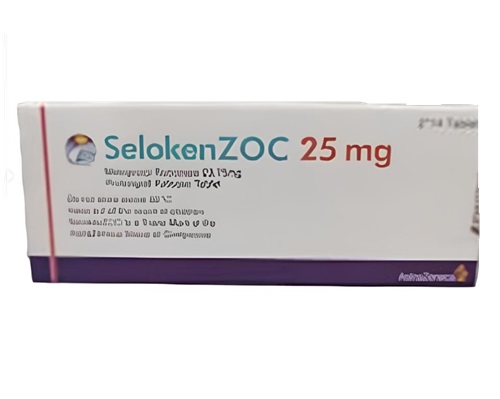Description
Tradename:
Seloken ZOC 200 mg
Compound:
Metoprolol succinate 190 mg, equivalent to 156 mg metoprolol
Metoprolol tartrate 200 mg
Properties:
Cardioselective beta1-blocker without intrinsic sympathomimetic activity. It has hypotensive, antianginal and antiarrhythmic effects. Reduces the automaticity of the sinus node, reduces heart rate, slows AV conduction, reduces myocardial contractility and excitability, reduces cardiac output, and reduces myocardial oxygen demand. Suppresses the stimulating effect of catecholamines on the heart during physical and psycho-emotional stress.
Causes a hypotensive effect, which stabilizes by the end of the 2nd week of course use. For angina pectoris, metoprolol reduces the frequency and severity of attacks. Normalizes heart rate during supraventricular tachycardia and atrial fibrillation. In case of myocardial infarction, it helps to limit the ischemia zone of the heart muscle and reduces the risk of developing fatal arrhythmias, and reduces the possibility of relapses of myocardial infarction. Prevents the development of migraine.
Indications:
Arterial hypertension, prevention of angina attacks, cardiac arrhythmias (supraventricular tachycardia, extrasystole), secondary prevention after myocardial infarction, hyperkinetic cardiac syndrome (including with hyperthyroidism, NCD).
Prevention of migraine attacks.
Directions for use and dosage:
The optimal dosage regimen is determined by the doctor. When taken orally, the average dose is 100 mg/day in 1-2 doses. If necessary, the daily dose is gradually increased to 200 mg. The maximum dose when taken orally is 400 mg/day.
Contraindications:
Hypersensitivity to metoprolol or other beta-blockers; AV block II and III degrees (without pacemaker); heart failure in the stage of decompensation; patients receiving long-term or intermittent therapy with inotropic agents and agents acting on beta-adrenergic receptors; clinically significant sinus bradycardia; SSSU; cardiogenic shock; severe disturbances of peripheral circulation, including with the threat of gangrene; arterial hypotension (systolic blood pressure less than 100 mm Hg); patients with acute myocardial infarction (heart rate less than 45 beats/min, PQ interval duration more than 0.24 seconds or systolic blood pressure less than 100 mm Hg); for the treatment of supraventricular tachycardia with systolic blood pressure less than 110 mm Hg. Art. ; intravenous administration of calcium channel blockers such as verapamil and diltiazem; simultaneous use of MAO inhibitors; severe forms of bronchial asthma and COPD; pheochromocytoma (without simultaneous use of alpha-blockers); breastfeeding period; children under 18 years of age.
Carefully:
1st degree AV block; Prinzmetal’s angina; COPD and mild bronchial asthma; diabetes; severe renal failure.
Precautionary measures:
Use with caution in patients with chronic obstructive respiratory diseases, diabetes mellitus (especially with a labile course), Raynaud’s disease and obliterating diseases of the peripheral arteries, pheochromocytoma (should be used in combination with alpha-blockers), severe renal and liver dysfunction.
During treatment with metoprolol, there may be a decrease in the production of tear fluid, which is important for patients who use contact lenses.
Completion of a long course of treatment with metoprolol should be carried out gradually (over a minimum of 10 days) under the supervision of a physician.
Concomitant use of metoprolol with MAO inhibitors is not recommended.
Side effects:
From the cardiovascular system: often – sinus bradycardia, decreased blood pressure, orthostatic hypotension (dizziness, sometimes loss of consciousness), postural disturbances (very rarely accompanied by fainting); rarely – decreased myocardial contractility, development of chronic heart failure (edema, swelling of the feet and/or lower legs, shortness of breath), heart rhythm disturbances, impaired myocardial conduction, cardialgia, manifestation of vasospasm (increased peripheral circulatory disorders, coldness of the lower extremities, Raynaud’s syndrome) ; very rarely – worsening of pre-existing AV conduction disorders, gangrene in patients with previous severe peripheral circulatory disorders.
From the nervous system: very often – increased fatigue, often – weakness, headache, slowdown in the speed of mental and motor reactions; rarely – paresthesia, convulsions, tremor, convulsions, depression, anxiety, decreased attention, drowsiness, insomnia, nightmares, confusion or short-term memory loss, hallucinations, asthenia, myasthenia gravis, impotence/sexual dysfunction, Peyronie’s disease; very rarely – amnesia/memory impairment, depression, hallucinations.
From the respiratory system: often – nasal congestion; uncommon – bronchospasm when prescribed in high doses (loss of selectivity





